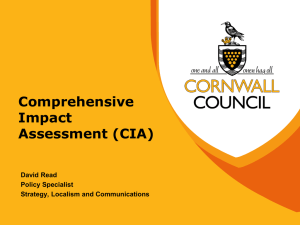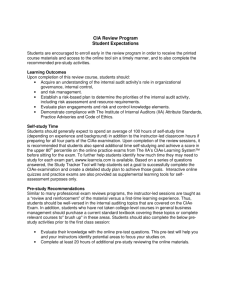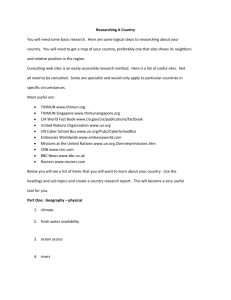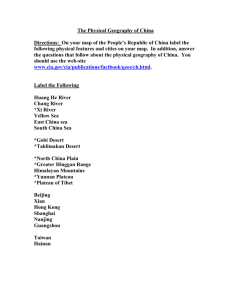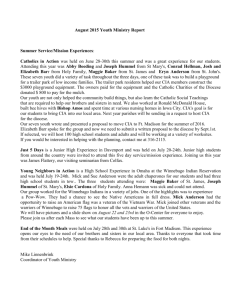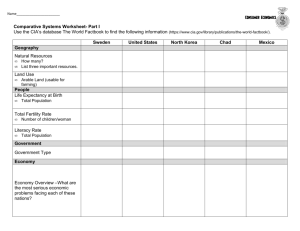File - Ms. Ku's Global Studies Class
advertisement
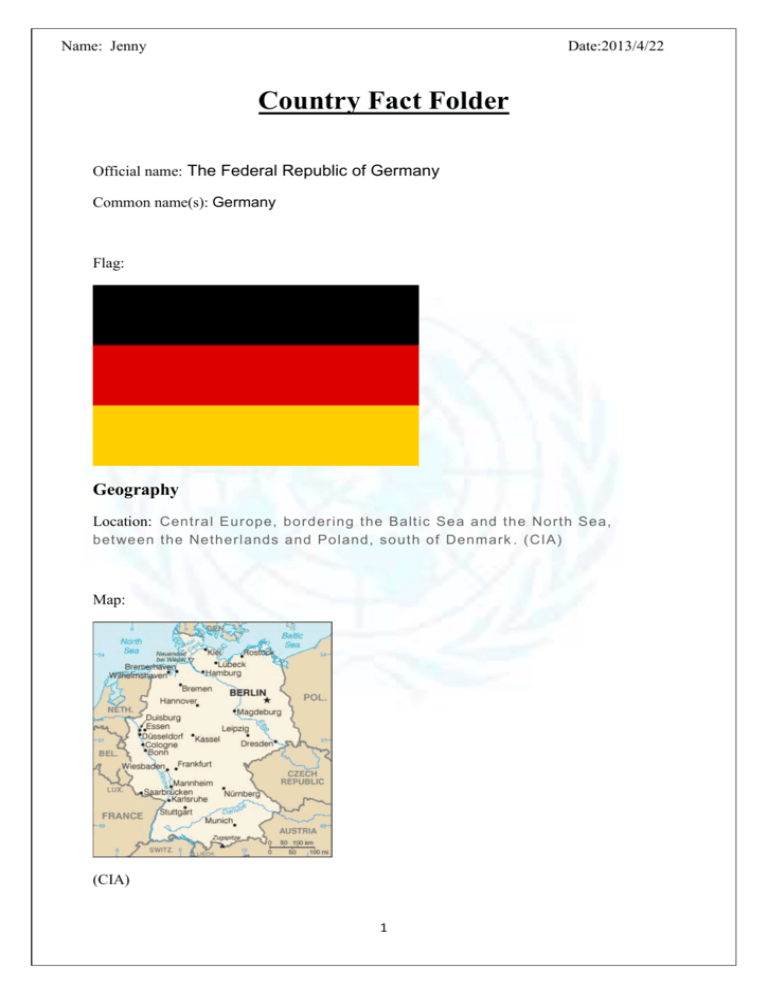
Name: Jenny Date:2013/4/22 Country Fact Folder Official name: The Federal Republic of Germany Common name(s): Germany Flag: Geography Location: Central Eur ope, bordering the Balt ic Sea and the North Sea, bet ween the Nether lands and Poland, south of Denmark . (CIA) Map: (CIA) 1 Area: a) Total: 357,022 sq km (CIA) b) Land: 348,672 sq km (C IA) c) Water: 8,350 sq km (CIA) Bordering nations: Austria 784 km, Belgium 167 km, Czech Republic 815 km, Denmark 68 km, France 451 km, Luxembourg 138 km, Netherlands 577 km, Poland 456 km, Switzerland 334 km (CIA) Natural resources, including well-known rivers, mountains, deserts, etc: coal, lignite, natural gas, iron ore, copper, nickel, uranium, potash, salt, construction materials, timber, arable land . (C IA) People Population: 81,147,265 (Jul y 2013 est.) (CIA) a) Total: 81,147,265 (CIA) b) Male: 39877075 (C IA) c) Female: 41270190 (CIA) Population growth rate (how quickly the population grows): -0.2% (2012 est.) (C IA) Birth rate (of X babies born, the % that survives): 8.33 births/1,000 population (2012 est.) (C IA) Life expectancy (for how many years is the average person able to live): Total population: 80.19 years (CIA) Male: 77.93 years (CIA) Female: 82.58 years (2012 est.) (C IA) What are the biggest ethnic groups? German 91.5%, Turkish 2.4%, other 6.1% (mad e up largel y of Greek, Italian, Polish, Russian, Serbo -Croatian, Spanish) (CIA) What are the most common religions? Protestant 34%, Roman Catholic 34%, Muslim 3.7%, unaffiliated or other 28.3% (CI A) Most common language(s) spoken: 2 German(CIA) How to say “hello” in most common language(s): Hallo Literacy (the % of people who can read and write): a) Total: 99% b) Male: 99% c) Female: 99% (2003 est. ) (CIA) Government Government type: f ederal republic ( CIA) Capital: Berlin Major cities: Hamburg, Munich, Cologne, Frankfurt(CIA) Independence (what year was the country established as a modern nation-state?): 18 Januar y 1871 (establishment of the German Empire); divided into f our zones of occupation ( UK, US, USSR, and France) in 1945 f ollowing World War II; Federal Republic of Germany (FRG or West Germany) pr oclaimed on 23 May 1949 and included the f ormer UK, US, and French zones; German Democrat ic Republic (GDR or East Germany) proclaimed on 7 October 1949 and included the f ormer USSR zone; W est Germany and East Germany unif ied on 3 October 1990; all f our power s f ormally relinquished rights on 15 March 1991; notable earlier dates: 10 August 843 (Eastern Fr ancia established f rom the division of the Carolingian Empire); 2 Februar y 962 (crowning of OTTO I, recognized as the f i rst Holy Roman Emperor) (CIA) Key political leaders: Alliance '90/Greens [ Claudia ROTH and Cem OEZDEMIR]; Christian Democrat ic Union or CDU [ Angela MERKEL]; Chr istian Social Union or CSU [Horst SEEHOFER]; Free Dem ocratic Par ty or FDP [ Philipp ROESLER]; Le ft Part y or Die Linke [Katia KI PPI NG and Bernd RIEXINGER]; Social Democrat ic Party or SPD [ Sigmar GABRI EL] (CIA) Participation in regional organizations, conventions, treaties, and agreements: ADB (nonregional member), Af DB (nonregional member), Arctic Co uncil (obser ver), Australia Group, BIS, BSEC ( obser ver), CBSS, CD, CDB, CE, CERN, EAPC, EBRD, ECB, EIB, EITI (implementing countr y), EMU, ESA, EU, 3 FAO, FATF, G-20, G-5, G-7, G-8, G-10, IADB, IAEA, IBRD, ICAO, ICC (national committees), ICRM, IDA, IEA, IFAD , IFC, IFRCS, IGAD (partners), IHO, ILO, IMF, I MO, I MSO, Interpol, IOC, IOM, IPU, ISO, ITSO, ITU, ITUC (NGOs), MIGA, NATO, NEA, NSG, OAS ( obser ver), OECD, OPCW, OSCE, Paris Club, PCA, Schengen Convention, SELEC (obser ver), SICA (obser ver), UN, UNAMID, UNCTAD, UNESCO, UNHCR, UNI DO, UNIFIL, UNMIL, UNMI SS, UNRWA, UNW TO, UPU, W CO, W HO, W IPO, W MO, W TO, ZC (CIA) Describe the country’s position and influence in its region: “A spectre is once again haunting Europe – the spectre of German power,” writes historian Brendan Simms in The New Statesman’s cover story Economy GDP: $3.123 trillion (2012 est.) GDP per capita: $39,100 (2012 est.) as of year(CI A) as of year(CI A) Agricultural products: potatoes, wheat, barley, sugar beets, f ruit, cabbages; cattle, pigs, poultr y( CIA) Industries: among the world's largest and most technologically advanced producers of iron, steel, coal, cement, chemicals, machiner y, veh icles, machine tools, electr onics, f ood and beverages, shipbuilding, text iles (CI A) What does the country import and export? Export: motor vehicles, machiner y, chem icals, computer and electronic products, electr ical equipment, pharmaceuticals, metals, trans port equipment, f oodstuff s, textiles, rubber and plast ic pr oducts (CIA) Import: machiner y, data processing equipment, vehicles, chemicals, oil and gas, metals, electr ic equipment, pharmaceuticals, f oodstuff s, agricult ural products(CI A) Which countries are your country’s biggest trade partners? China is becoming the biggest trade partners. () Currency: 4 EUR(zhidao, baidu) Exchange rate: (i.e. RMB 6.1 = USD 1) Military Military branches (the different parts of the military): Federal Armed Forces (Bundesw ehr): Army (Heer), Navy ( Deutsche Marine, includes naval air ar m), Air Force (Luftwaff e), Joint Support Ser vices (Streitkraeftbasis), Central Medical Ser vice (Zentraler Sanitaetsdienst) (2013) Manpower available for military service: a) Total: 36417842 b) Males: 18,529, 299 c) Females: 17,888,543 ( 2010 est.) Military expenditures (% of GDP): 1.5% of GDP (2005 est.) International Issues Military, political, and border disputes: None Economic disputes: Environmental problems: emissions f rom coal - burning utilitie s and industries contribute to air pollut ion; acid rain, result ing f rom sulf ur dioxide emissions, is damag ing f orests; pollut ion in the Baltic Sea f rom raw sewage and industrial eff luents f rom rivers in eastern Germany; hazardous waste disposal; government established a mechanism f or ending the use of nuclear power over the next 15 years; government working to meet EU commitment to ident if y nature preser vat ion areas in line with the EU's Flor a, Fauna, and Habitat direct ive 5 Illicit trade (drugs, weapons, people, etc): source of precursor chemicals f or South American cocaine pr ocessor s; transshipment point f or and consumer of Southwest Asian her oin, Latin American cocaine, and European -produced synthetic dr ugs; major f inancial center Refugees and displaced persons: ref ugees (country of origin): 110,455 Ser bia; 92,986 Turkey; 48,976 Iraq; 39,816 Russia; 30,425 Af ghanistan; 24,261 Vietnam; 24,016 Bosnia and Her zegovina; 20,462 Iran; 19,922 Ukraine; 11,724 Sri Lanka; 11,697 Lebanon; 10, 155 Syr ia; 6,368 Azer ba ijan; 5,982 Macedonia; 5, 146 Democrat ic Republic of the Congo (2011) Other disputes and issues: Bibliography: 1.About introduction, economy, military, communication, and international issues. < https://www.cia.gov/library/publications/the-world-factbook/geos/gm.html > 2. China’s biggest trade partner. < http://www.cs.com.cn/sylm/jsbd/201202/t20120202_3225969.html > 3. About the country’s position and influence in its region < http://www.presseurop.eu/en/content/news-brief/3543801-problem-germany > 4. Currency < http://zhidao.baidu.com/question/80222326.html > 18/20 6
